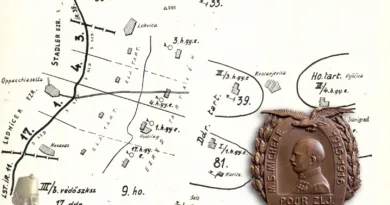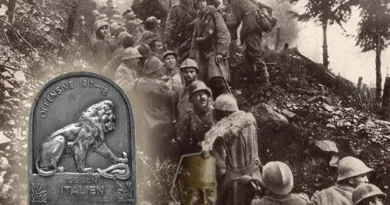January 1917 in Volhynia
There is a very curious badge that shows a German and a A-H infantryman. In their hands, as in the case of the saints, are weapons as a sign of recognition: the German holds a two-handed sword, the Austro-Hungarian buck holds a mace. For me, of course, the interpretation of the mace is more interesting.
This is the insignia of the “reinforced” 215th division, made by the Gurschner company in Vienna. It was not uncommon to depict allied soldiers together as an expression of friendship for arms. This is confirmed by the shield held jointly by the two soldiers in the middle. Below this German eagle is the Austro-Hungarian triple coat of arms. The year 1917 can be read above. The main problem is that there was no 215th division in the army of the Monarchy.

Returning to the mace, we also see this melee weapon on the insignia of the 20th Honvéd Division, which was called “the twenty”. This is an important clue in deciphering. It is worth rummaging through the commemorative books of the division’s regiments (1st, 3rd, 4th and 17th Honvéd infantry regiments) that saw many battles. Instead of describing the long viewing, getting straight to the point, in the book of the 4th honvéd infantry regiment, there is a whole chapter about the rest of the regiment in Volhynia in 1917. More precisely, between November 20, 1916 and September 1, 1917, the regiment was on the Russian front.
Here we can read that the honvéd regiment was transferred from the positions in Volhynia at the end of 1916 to the vicinity of the 215th German Division around the New Year. Since there is no trace of similar move in the other regiments, I believe that only the 4th were transferred to this German division. The purpose of mixing the troops was to strengthen friendship. No serious fighting took place in this position. The honvéds perfected their positions and performed their duties accurately. As a consequence of this, the German squadrons mixed in between them were gradually reassigned by the Germans to their own troop units. The initial mistrust was over. Later, exchanges of orders took place between the officers to promote friendship. The unit was visited by corps commander Falkenhayn and later by army commander Linsingen as well.
Regarding the activities of the resting regiment, the historian saw it as appropriate to capture such events as the gathering of field flowers on Queen Zita’s name day, the visit of the civil leaders of the city Nagyvárad to the regiment at the front, and the cultural events of the Ottó Soldiers’ Home. Due to the outbreak of the Russian Revolution, hostilities were suspended. The regimental history does not mention battles at the time of the Kerensky offensive either. The opening image of the post shows the ornate entrance to the Zita mSoldiers’ Home built at the same time by the 17th honvéd infantry regiment. Nice place for entertainment, isn’t it?




